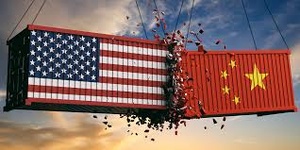With just 29 days remaining before President Trump’s next major tariff truce with China expires on August 12, exporters across the country have launched an all‑out effort to mitigate the looming risk of duties reverting to levels exceeding 100 percent. As this deadline approaches, firms are racing to accelerate shipments, reroute trade paths and engage in intensified talks with both domestic and overseas partners to secure favorable outcomes before higher tariffs kick back in.
Frontloading Shipments to Beat the Clock
Customs figures for June revealed a 5.8 percent year‑on‑year rise in outbound shipments, up from May’s 4.8 percent gain, indicating that exporters are accelerating orders to capitalize on temporarily reduced duties. The United States remains the focal point of this surge: shipments to American ports jumped 32.4 percent month‑on‑month, marking the first full month under the lowered tariff regime. Nonetheless, year‑on‑year exports to the U.S. continue to contract amid persistent demand challenges.
Many manufacturers are offering steep early‑order discounts to secure commitments from U.S. distributors willing to finalize purchases before the August cutoff. Electronics, high‑margin components and textiles top the list of priority goods, with factories in Guangdong and Jiangsu operating near full capacity to ulfil advance orders. Container lines sailing from Shanghai, Ningbo and Shenzhen are reporting record booking volumes, while freight forwarders are advising clients to lock in space immediately to avoid potential port congestion in Los Angeles, Long Beach and Houston.
In parallel, apparel and lower‑value consumer goods exporters are increasingly utilizing bonded warehouses in Shanghai and Shenzhen. By storing goods under bond, companies can defer customs declarations until the last permissible moment, thereby extending the window to ship at reduced rates. This tactic has prompted warehouse rental rates in key coastal hubs to spike by up to 20 percent over the past month, according to logistics insiders.
Trade Diversification and Rerouting Strategies
While frontloading remains paramount, Chinese exporters are simultaneously pursuing market diversification as insurance against a potential tariff rollback. June saw outbound shipments to ASEAN nations climb 16.8 percent, with Vietnam, Thailand and Malaysia emerging as critical transshipment points. In Vietnam, in particular, Chinese firms have been rapidly setting up assembly and repackaging operations to classify goods as local output, thereby circumventing U.S. duties upon onward shipment.
Trade data indicate a sharp uptick in Vietnam‑to‑U.S. exports of electronics, furniture components and plastics, with some sectors reporting month‑on‑month increases exceeding 40 percent. Thailand and Malaysia are also playing host to expanded warehousing facilities, housing containers awaiting re‑export once duties are reduced—or, if necessary, shipped on to alternative markets such as Europe and Latin America.
Rare earths—a sector of strategic significance—are experiencing a parallel export revival. June exports rose by approximately one‑third compared with May, part of broader efforts to unlock recently negotiated agreements easing supply restrictions. With European automakers and aerospace firms hungry for stable rare earth supplies, Chinese producers are confident that demand will absorb increased volumes even if U.S. tariffs bite.
In addition, exporters are deepening ties with buyers in the European Union and Mercosur bloc. Shipments to the EU climbed close to 10 percent in June, buoyed by the suspension of anti‑dumping proceedings against Chinese solar panels. In South America, Chinese soy and petrochemical shipments are moving under preferential Mercosur tariff schedules, further balancing the risk of an abrupt reversal in U.S. trade policy.
Diplomatic Engagement and Financial Incentives
Beyond logistics and market realignment, Beijing has mobilized diplomatic and fiscal tools to ease pressure on its exporters. Over the past fortnight, senior commerce ministry officials have dispatched envoys to Washington and Brussels, advocating for an extension of the tariff pause and negotiating incremental duty roll‑backs based on progress in sensitive sectors such as semiconductors, pharmaceuticals and energy.
Domestically, the Ministry of Finance has earmarked an additional 50 billion yuan to support small and medium‑sized exporters. Measures include subsidized freight co‑financing, expanded loan guarantees and tax rebates linked to export performance. Local governments in Guangdong, Zhejiang and Shanghai are complementing these efforts with operational grants and rent waivers for manufacturing and logistics firms directly impacted by the tariff stalemate.
Private‑sector associations have also stepped up, lobbying Beijing for broader “operational subsidies” to cover incremental costs stemming from higher insurance premiums, labor overtime and storage fees. Some industry groups are even exploring collective bargaining mechanisms to negotiate with freight carriers for longer‑term rate locks, aiming to stabilize shipping costs beyond the August deadline.
Investors have reacted cautiously optimistic to these developments. China’s benchmark CSI300 index rose 0.2 percent midday, while the Shanghai Composite gained 0.4 percent—moves reflecting hopes that frontloading and policy support will sustain export growth into the final quarter. Yet analysts warn that once the initial surge in shipments subsides, export growth may decelerate sharply if tariffs remain elevated above 25 percent.
Looking ahead, exporters face a dual challenge: sustaining momentum in existing markets while securing access to alternative destinations should the truce collapse. With fewer than four weeks to navigate this complex landscape, companies are pulling every lever—from accelerated production and bonded warehousing to diplomatic outreach and financial subsidies—to shape the outcome of Trump’s August 12 deadline. Their success or failure will have profound implications for global supply chains and China’s economic trajectory as summer turns to autumn.
(Source:www.wionnews.com)
Frontloading Shipments to Beat the Clock
Customs figures for June revealed a 5.8 percent year‑on‑year rise in outbound shipments, up from May’s 4.8 percent gain, indicating that exporters are accelerating orders to capitalize on temporarily reduced duties. The United States remains the focal point of this surge: shipments to American ports jumped 32.4 percent month‑on‑month, marking the first full month under the lowered tariff regime. Nonetheless, year‑on‑year exports to the U.S. continue to contract amid persistent demand challenges.
Many manufacturers are offering steep early‑order discounts to secure commitments from U.S. distributors willing to finalize purchases before the August cutoff. Electronics, high‑margin components and textiles top the list of priority goods, with factories in Guangdong and Jiangsu operating near full capacity to ulfil advance orders. Container lines sailing from Shanghai, Ningbo and Shenzhen are reporting record booking volumes, while freight forwarders are advising clients to lock in space immediately to avoid potential port congestion in Los Angeles, Long Beach and Houston.
In parallel, apparel and lower‑value consumer goods exporters are increasingly utilizing bonded warehouses in Shanghai and Shenzhen. By storing goods under bond, companies can defer customs declarations until the last permissible moment, thereby extending the window to ship at reduced rates. This tactic has prompted warehouse rental rates in key coastal hubs to spike by up to 20 percent over the past month, according to logistics insiders.
Trade Diversification and Rerouting Strategies
While frontloading remains paramount, Chinese exporters are simultaneously pursuing market diversification as insurance against a potential tariff rollback. June saw outbound shipments to ASEAN nations climb 16.8 percent, with Vietnam, Thailand and Malaysia emerging as critical transshipment points. In Vietnam, in particular, Chinese firms have been rapidly setting up assembly and repackaging operations to classify goods as local output, thereby circumventing U.S. duties upon onward shipment.
Trade data indicate a sharp uptick in Vietnam‑to‑U.S. exports of electronics, furniture components and plastics, with some sectors reporting month‑on‑month increases exceeding 40 percent. Thailand and Malaysia are also playing host to expanded warehousing facilities, housing containers awaiting re‑export once duties are reduced—or, if necessary, shipped on to alternative markets such as Europe and Latin America.
Rare earths—a sector of strategic significance—are experiencing a parallel export revival. June exports rose by approximately one‑third compared with May, part of broader efforts to unlock recently negotiated agreements easing supply restrictions. With European automakers and aerospace firms hungry for stable rare earth supplies, Chinese producers are confident that demand will absorb increased volumes even if U.S. tariffs bite.
In addition, exporters are deepening ties with buyers in the European Union and Mercosur bloc. Shipments to the EU climbed close to 10 percent in June, buoyed by the suspension of anti‑dumping proceedings against Chinese solar panels. In South America, Chinese soy and petrochemical shipments are moving under preferential Mercosur tariff schedules, further balancing the risk of an abrupt reversal in U.S. trade policy.
Diplomatic Engagement and Financial Incentives
Beyond logistics and market realignment, Beijing has mobilized diplomatic and fiscal tools to ease pressure on its exporters. Over the past fortnight, senior commerce ministry officials have dispatched envoys to Washington and Brussels, advocating for an extension of the tariff pause and negotiating incremental duty roll‑backs based on progress in sensitive sectors such as semiconductors, pharmaceuticals and energy.
Domestically, the Ministry of Finance has earmarked an additional 50 billion yuan to support small and medium‑sized exporters. Measures include subsidized freight co‑financing, expanded loan guarantees and tax rebates linked to export performance. Local governments in Guangdong, Zhejiang and Shanghai are complementing these efforts with operational grants and rent waivers for manufacturing and logistics firms directly impacted by the tariff stalemate.
Private‑sector associations have also stepped up, lobbying Beijing for broader “operational subsidies” to cover incremental costs stemming from higher insurance premiums, labor overtime and storage fees. Some industry groups are even exploring collective bargaining mechanisms to negotiate with freight carriers for longer‑term rate locks, aiming to stabilize shipping costs beyond the August deadline.
Investors have reacted cautiously optimistic to these developments. China’s benchmark CSI300 index rose 0.2 percent midday, while the Shanghai Composite gained 0.4 percent—moves reflecting hopes that frontloading and policy support will sustain export growth into the final quarter. Yet analysts warn that once the initial surge in shipments subsides, export growth may decelerate sharply if tariffs remain elevated above 25 percent.
Looking ahead, exporters face a dual challenge: sustaining momentum in existing markets while securing access to alternative destinations should the truce collapse. With fewer than four weeks to navigate this complex landscape, companies are pulling every lever—from accelerated production and bonded warehousing to diplomatic outreach and financial subsidies—to shape the outcome of Trump’s August 12 deadline. Their success or failure will have profound implications for global supply chains and China’s economic trajectory as summer turns to autumn.
(Source:www.wionnews.com)






